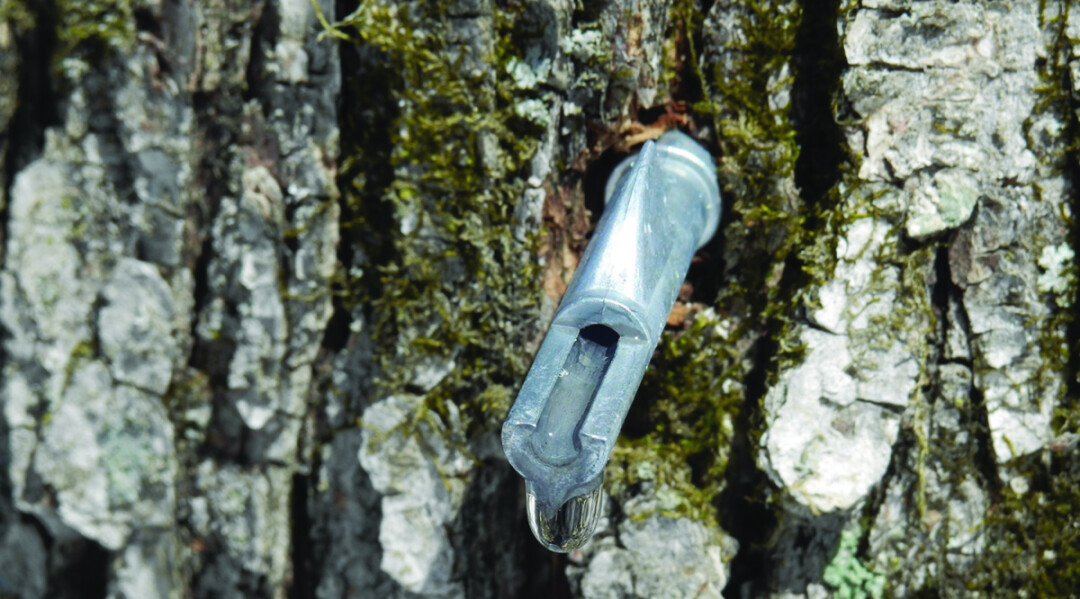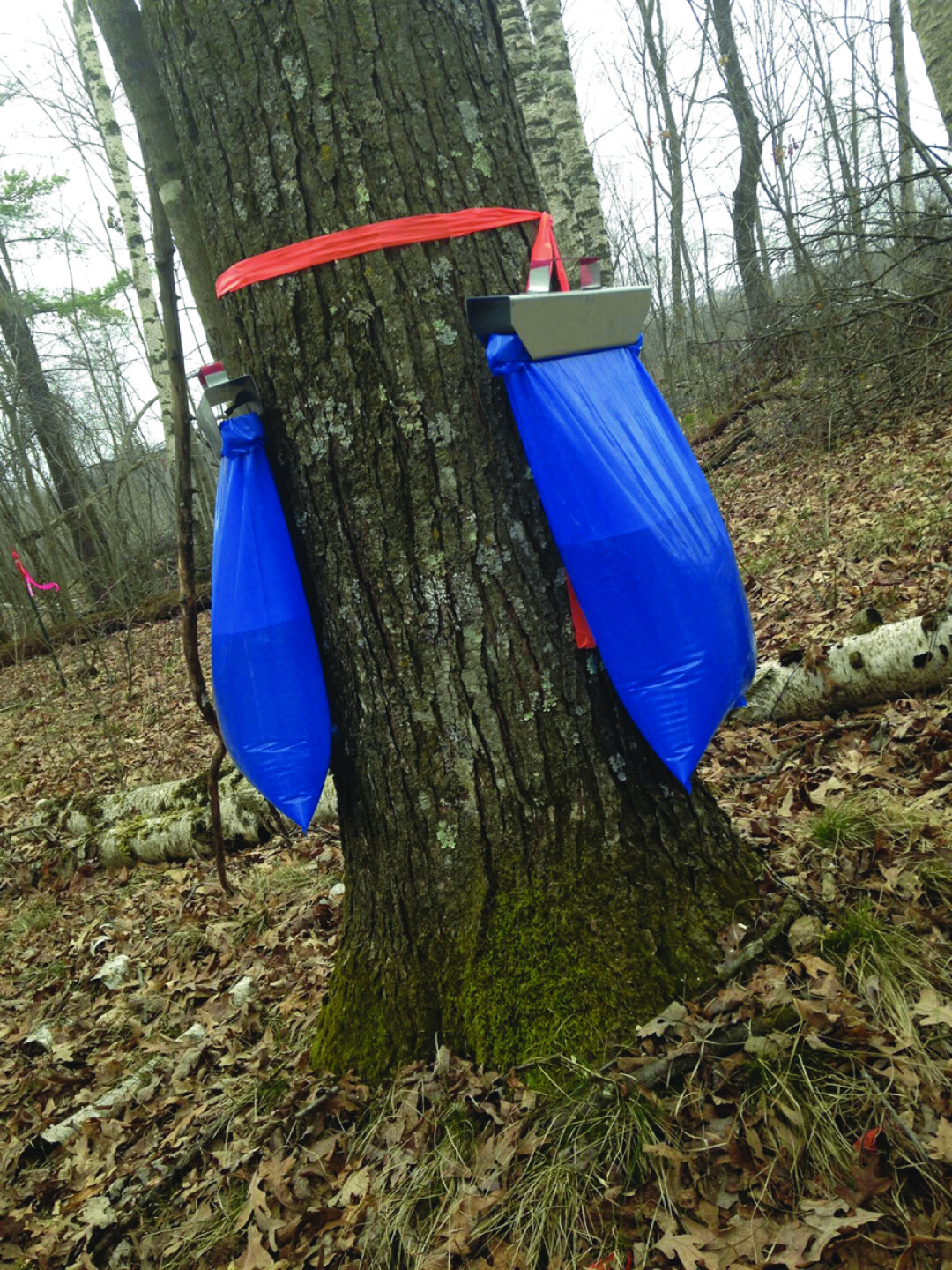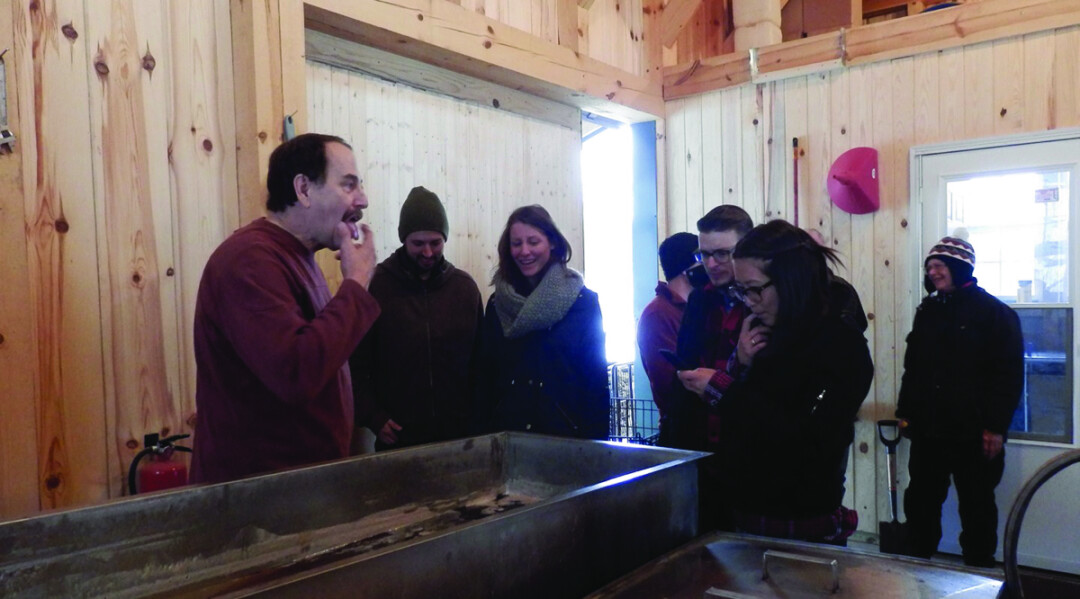The Sticky Path to Happiness and Culinary Bliss: Life as Maple Syrup
through good years and bad, making maple syrup teaches us how to distill the sweetness from life
Gil Vernon, photos by Gil Vernon |

No apology is offered for the title. Because when truth hits you in the face there is no hiding place. The lessons of making maple syrup turn out to be inescapable. Here is the big one: The sweetness of life is all around you. One merely needs to time it, to tap into it, to collect it, and to distill away the extraneous. Combine that with preparation, hard work, and patience, and you will have something not only satisfying and heavenly for the taste buds but you will also have a pretty good template for life.
It took 50 years to figure this out. It started with cold nights and cabin fever. Add good neighbors, a wood fire, and beer (the Wisconsin Trinity), and it was a perfect environment to learn about “sapping.” Helping the farmer down the road with his sugar bush in the spring evolved into tapping my own maples, building my own sugar shack, and spending my own all-nighters boiling sap. It also led to realizing the whole process has unimaginable benefits when compared to simply pouring syrup on pancakes. As it is said, a lesson learned late is better than a lesson never learned.
A hole 5/16” of an inch wide and 1-1/2” deep drilled into any kind of maple tree at the right time of the year (timing is important in all things) starts a drip – drop by drop, plinking and plunking in alliance with the 3 million other drips of sap it takes to make a gallon of syrup. The sap is clear as water because it is 96 to 98 percent water with a sugar content of only 2 to 4 percent. When you get rid of most of the water, you have syrup.

Tapping occurs in the spring of the year and is weather dependent. There is no precise date, but generally in Wisconsin you should be ready by March 15 and be prepared to collect and boil until April 15. The only thing that is predictable is the unpredictability. It isn’t just warm days that make sap move from the roots up to feed buds and eventually produce leaves. It takes warm days and cold nights. The temperature change from freezing nights to thawing days and back again creates pressure changes in the tree that induce the sap to flow in all directions, including through the hole you drilled. It starts the drip. Think of it as similar to what happens when you squeeze, hold, and release your fingers. The message for life is: Change and pressure are good if channeled and processed in a paced and productive way.
The sap stops running when the nights get too warm. A season can abruptly end or start and stop and restart depending on nighttime temperatures. Too many warm nights and the buds will start to open, stealing sugar from the sap and giving an off-taste ending the season.
Through the tap (a metal or plastic spout hammered gently into the tap hole) the sap flows into buckets or bags or tubes run to a central collection tank. Large producers even introduce vacuum pumps to draw the sap out and move it through the lines (think of a milking machine). At the peak of the run, a single tap will put out from 2 to 5 gallons of sap a day.
How does maple sap start out as something clear and as thin as water and end up caramel-colored, thick, and sticky? The answer is most of the water (90 to 97 percent) must be evaporated. The variance relates to the sugar concentration in the sap that differs from one species of maple to another and decreases as the season progresses. To put into perspective the amount of water that needs to be removed, consider this: It takes approximately 40 gallons of sap to produce 1 gallon of syrup. The 1 gallon of liquid left after processing is maple syrup and it doesn’t get this crown unless it has a sugar concentration of at least 66.9 percent.
Ideally, the sap collected in a day should be processed within 24 hours. After collecting sap, a race against time starts. If the sap isn’t processed quickly or if it is not chilled, the sugar content degrades. This explains why processing often is a round-the-clock operation during the season. Accordingly, the capacity of the evaporating system should be matched to the number of sap-producing taps. Our operation is delightfully inefficient. It takes us about 24 hours to boil enough sap to make 5 gallons of syrup. It gives us more time to gather around the fire and wake up acquaintances with friends and neighbors after our collective hibernations.

The process of removing the water (or the inverse: concentrating the sugar content) can be simple or complicated. The result is the same, and from experience the simple approach is just as satisfying. Perhaps it is so in life. As for maple syrup, the traditional method is to boil the sap in a flat stainless steel pan that in a “hobby” operation is about 2 feet by 4 feet. The pan sits on top of a vessel capable of holding a wood fire and venting the smoke. It could be as simple as a pile of rocks and a pot. Light a fire, feed the fire, and keep adding sap until what’s left smells and looks like syrup. Or it could be complicated. Modern maple syrup machinery looks like the guts to a NASA Saturn rocket.
No matter what method is used, in the end nothing could be more pure or natural. Nothing at all is added to the sap during processing. The sweetness remaining is completely the product of subtraction – not addition, not accumulation. This isn’t a bad lesson in and of itself. Concentrate on goodness, and disregard everything that doesn’t add to it.
The modern high-production process to remove water from sap is reverse osmosis. The end result is that 70 to 80 percent of the water that needs to go is removed by a pressurized filtering system, and then the remaining is boiled in a continuous flow method in which small amounts of finished product at the end of the baffles or channels is automatically drawn off as fresh sap is introduced at the other end. The syrup is lighter in color than the traditional batch process. In the latter case, the sap stays on the fire longer. The longer the time on the fire the darker the syrup and the more complex and palpable to your taste buds. By either method heat is required at some point. The heat source could be wood, gas, or oil. Heat is energy and neither maple syrup nor happiness is made without it.
The question is which is better, light or dark syrup? That used to be a raging debate because the official grading system used to favor lighter syrup, dubbing light syrup Grade A and darker syrup Grade B. This was upside down according to the opinion of the common consumer and connoisseurs. Almost everyone agreed darker syrup tasted better. The grading system that went into effect in 2015 gives the Grade A stamp based on taste, not color. The new system gives Grade A to any of the following:
• Golden Color and Delicate Taste
• Amber Color and Rich Taste
• Dark Color and Robust Taste
• Very Dark Color and Strong Taste
Old fashioned batch-processed syrup boiled over wood – which is gathered throughout the year – rather than reverse osmosis continuous processed syrup is preferred by many not only for the aesthetics but also because it is darker and has a broader spectrum of tastes. You can trust that somebody cared about it, fretted over it, probably lost sleep over it, and stood over the pan numerous times inhaling, oohing, aahing, and thinking, “Oh my God, there is no better smell in the world.” In the Upper Midwest the smell of a good batch of syrup even inspires an “uff da” or two in the traditional understated Scandinavian way. The other bonus for the old- fashioned batch processor is that when you drain the pan there is caramelized foam that sticks to the sides of the pan. One finger-dip of this sends you back to your childhood where you stood on a chair waiting anxiously for mom to finish frosting the cake so you could lick the bowl. This once-a-year maple treat sends you over the maple moon.

Perhaps the best way to explain the benefits of batch processing is to think of Grandma’s chicken noodle soup. Wasn’t it better the longer it spent simmering on the stove? The benefit of batch processing has caught on in other culinary circles. Small batch processed bourbons and other liquors are coveted.
Apologies are offered here for using the “S” word: sugar. It has been made out to be evil. Yet like fairies and witches, there are good sugars and bad sugars. Maple syrup, which can be crystallized if you prefer, is a good source for this dietary staple.
The chemical analysis of maple syrup, according to the research, is enough to make your head spin. It is enough to know that 3.5 ounces of maple syrup will provide you 157 percent of your daily recommend dose of magnesium, 44 percent of zinc, 9 percent of iron, 7 percent of calcium, and on down the line. Some have said that maple syrup is the new “super food” taking a vaunted place along with broccoli, blueberries, red wine, green tea, flax, and whole wheat. A very serious researcher at the University of Rhode Island called it an “antioxidant cocktail.” In addition to essential minerals and antioxidants (which prevent aging of cells) maple syrup is high in water-soluble compounds (polyphenol) that inhibit the enzymes that convert carbohydrates to sugar. The research raises the possibility maple syrup may play a role in managing Type 2 diabetes. This may also explain why my diabetic neighbor discovered he tolerates maple syrup far better than other sugars. It should be used as a replacement – not a supplement – to other sources of sugar.
Scientists have identified 91 different unique flavors in maple syrup, including the vanilla and floral and many of the same flavor notes found in wine tasting. Indeed, scientists and others with not enough to do (and looking for Food Channel gigs) are analyzing soil types for maple trees in the same way wine connoisseurs are researching soil types for the best grapes (the “gout de terroir” or taste of the place).
More important and far less snooty than wine-like analysis of maple syrup is this fact: It is just not for breakfast anymore, although my daughter religiously spikes her morning joe with maple syrup. The best cookie I have ever had is baked with maple syrup with no processed white granulated sugar. I learned to like Brussels sprouts baked and glazed with maple syrup. A soy maple marinade will elevate your pork, beef, or venison loin to grill nirvana. It makes a heck of a cocktail too or keep it simple and just splash a dash in your glass of Bushmills. Add a few friends, a fire, a Leinenkugel’s, and a steaming pan of sap, just as a warm March sunset yields to a crisp Wisconsin night, and you could die happy.
Gil Vernon is a professional arbitrator and longtime Chippewa Valley resident. He produces maple syrup from about 380 trees on property in northern Dunn County. Learn more at unclegillysmaplesyrup.com or facebook.com/UncleGillysMapleSyrup.
Maple Date Pecan Cookies
Ingredients for cookies
• 1 cup butter, softened
• 3 eggs
• 1 cup maple syrup
• 3 1/4 cups all-purpose flour
• 1 teaspoon baking powder
• 1 teaspoon baking soda
• 1 teaspoon salt
• 1 cup chopped dates
• 1 cup chopped pecans
• 3/4 cup flaked coconutIngredients for frosting
• 1/4 cup butter, softened
• 1 cup confectioners’ sugar
• 2 tablespoons heavy whipping cream
• 1 tablespoon maple syrup
• 1 teaspoon vanilla extract
• 1/4 teaspoon maple flavoringDirections
In a large bowl, cream butter until light and fluffy. Add eggs, one at a time, beating well after each addition. Beat in syrup (mixture will appear curdled). Combine the flour, baking powder, baking soda and salt; gradually add to the creamed mixture and mix well. Stir in dates, pecans, and coconut. Cover and refrigerate for 2 hours or until easy to handle.
Drop by rounded teaspoonfuls 2 inches apart onto greased baking sheets. Bake at 350 degrees for 9-11 minutes or until edges are lightly browned. Cool for 2 minutes before removing to wire racks.
In a small bowl, cream butter and sugar until light and fluffy. Beat in the cream, syrup, vanilla, and maple flavoring until smooth. Frost cooled cookies.Yield: About eight dozen.
Gil Vernon’s Maple Bush
Step 1: Make a simple maple base
• Add ½ cup of maple syrup to ½ cup of water in a saucepan and turn the heat to medium.
• Whisk the ingredients together until the maple syrup has dissolved into the water – which is far from the boiling point – and then remove from heat.
• Allow to cool.Step 2
Combine 1 tablespoon of the maple base with two ounces of Bushmills Irish Whiskey, pour over ice, stir, and add a strip of lemon peel. Cherry garnish optional.























